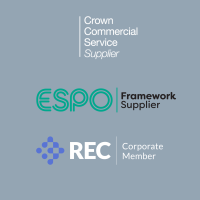
Philharmonia Orchestra: Taking Steps to Address Bias Within Recruitment
We spoke with the Philharmonia Orchestra’s Interim Head of Marketing, Katie Vickers and Maurice Mueller, their newly recruited Marketing Assistant, to find out more about what they have to done to tackle unconscious bias in their recruitment processes.
Why did you choose to use a platform for debiased recruitment for this role?
Katie: The Philharmonia Orchestra is very committed to trying to diversify our workforce, and by that we mean who’s playing in our orchestra as well as who’s working behind the scenes. One of the ways we’re trying to do that is by trying to take unconscious bias out of the recruitment process; in auditions as well as internal recruitment. In auditions, it involves physical screens so that when the person comes into the room, the audition panel can’t see them.
Our newly appointed Head of Finance, Kate Collis, had used as a specialist provider in a previous role for recruiting, and she suggested that we try the platform to aid our unbiased recruitment process.
We had already tried our own home-made version, which involved somebody from a different team to get, literally, a black Sharpie and cross out anything that might give you a clue to their ethnicity, where they went to university, and anything in their application that might indicate their gender. But we realised that there are other really clever ways of doing it that didn’t involve a black Sharpie.
There are also lots of different reasons that bias creeps in when you’re looking at huge piles of CVs. For example you’re more likely to put a CV in the bin if you’re hungry, and less likely to select the 15th CV you look at…did you just have a biscuit? There are a lot of other reasons, apart from the obvious things like names, university etc. that might impact your bias.
How did the process work?
Katie: In the past we were working with CVs and covering letters but with the platform we used you set a list of questions specifically related to the job description.
When you create a personal specification you state competencies that the desired person will have to be able to perform the role i.e. ‘you have to be able to do X, Y, and Z’. When formulating the questions you are looking to see that the applicant’s answer shows whether they could actually do X, Y, or Z.
Answers are assessed by a mark scheme between 1 and 5. A 5-point answer would be a top tier candidate where their answer shows they could go above and beyond your expectations; solve a problem, come up with their own solution, whatever qualities you’re looking for in that person. A 1 out of 5 answer would be if the candidate doesn’t understand the question, or they don’t think this question is relevant to their job, or they’ve got the wrong end of the stick.
The candidates access the platform to complete the application. Answers from all the candidates get muddled up, so you don’t see Person A’s answer to questions 1, 2, 3, 4, 5, you see an answer to question 3, an answer to question 1, an answer to question 5 from a selection of candidates.
You also share the marking between your team and they specifically recommend that you ask a range of people from different levels within the organisation. It also gives each person less work. Say you have 10 applicants and they’ve each answered 6 questions, that means you’ve got 60 answers which for one person is time consuming. However the platform will just send you 15 answers and that’s your bit done. My team was surprised how incredibly quick the process took compared to when you’re faced with a massive pile of CVs and covering letters.
Then it really cleverly amalgamates everyone’s marks and ranks everybody. You’ll chose the top 3 who overall performed the best to interview, but you don’t know until then whose answer came from who.
What was the candidate experience like?
Maurice: For me, it was definitely much more of a commitment towards the application. I normally try to be a bit more selective with roles because it doesn’t make sense to apply if it’s not something you really want to do.
I had come across debiased recruitment for a different role during my search. From the job description it sounded like it would be a great role for me, but then I was put off by the questions. I realised that it was more senior and it wouldn’t make sense for me to go through all the questions when I don’t have the experience to answer them. The questions help to show the real, on-the-job experience needed rather than just more meta questions of how you would approach something.
Then with this role at Philharmonia, I could see from the description and reading the person specification that I would be suited for the role, and when I looked at the questions I thought ‘Okay, this is something I can actually answer and I am able to give a valuable or sensible answer.’
The questions are also useful to give an idea of the job as well and knowing what is expected from you. In a traditional recruitment process, you have different lists of requirements of what you’re expected to do, but little idea as to what it would actually mean i.e. what would you do in situation X, Y, Z? By seeing this description of the situation, you can understand more practically what this role is about.
It was also great to see a commitment from Philharmonia in trying to avoid unconscious bias, being more open and more diverse or at least more unbiased in their processes. I realized that I would like to work for the kind of organisation that knows this is important, and they’re making it very clear that they know it’s important.
I studied Musicology and being from this environment, you often feel like you can be part of the problem. I’m white, I’m of European descent and I am conscious that I have been able to study at great universities. I don’t want to put other people out of the recruitment process by me being able to list all these things that perhaps other people cannot. This is fairer as it gives everybody a chance and removes the influence of privilege in the recruitment process.
What were the challenges of recruiting in this new way?
Katie: We got far fewer applications because it’s quite hard work to complete the answers. You have to really think about the job and how you would handle certain situations, which you normally wouldn’t be asked until you come to interview.
You have to be really interested in the role and you have to want to put some time into it. You can’t just download your CV, change the first line to, ‘Dear Philharmonia person,’ and press send. So it gets rid of all the people who are just applying for every single arts job they can see and sending the same CV to everyone with just a very slightly adapted covering letter that they’ve just copied and pasted. They don’t even bother applying because it looks too much like hard work.
It made me a little bit nervous not seeing people’s CVs and it was the first time using the platform, so we request them but don’t look at them until after we’d shortlisted. Apparently companies often do this the first few times and then once they’ve got used to how the platform works and they’re confident that they’re getting the right people, they feel more comfortable not seeing CVs.
What were the unexpected benefits of using the platform?
Katie: Putting the questions together took a long time, but going through the applications was very, very quick. Partly because there weren’t very many and partly because the work was shared. Having a marking system also made reviewing applications quicker as you didn’t need to spend time deciding how to judge each one.
We did end up interviewing somebody who very much wasn’t from a classical music background. She was interested in music as a performer, but she hadn’t been to university to study music, so it did add variety to the pool of candidates.
The fact that you are giving the candidates a practical idea of what the job might involve is a good advantage too because they can decide whether to apply or not.
Is it something that you’re going to take forward?
Katie: Yes, we’re already using it for a second process in a different department. We plan to use it throughout this year and see how it goes, and then hopefully, continue if everyone’s felt that it’s been successful.
We’ve got Maurice, which is great and he is a good fit for the organisation.
Philharmonia Orchestra used BeApplied to help with the recruitment of this role.



